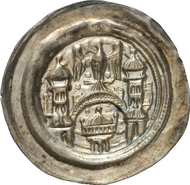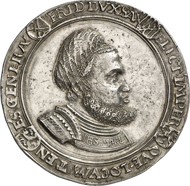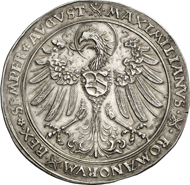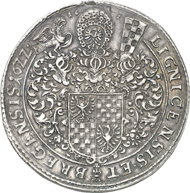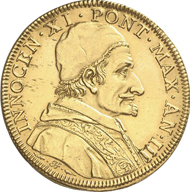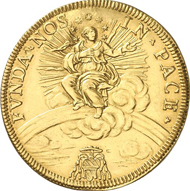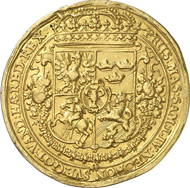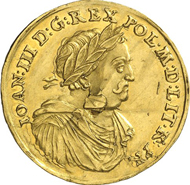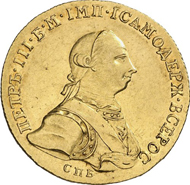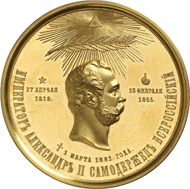16-06-2013 – 20-06-2013
Auction sales 232-235
Numismatic beginning of summer in Osnabrück
With Künker the German auction year starts in Berlin and with Künker the spring season ends in Osnabrück. Shortly before the summer break, Künker puts on its auction week from June 17 to 21, 2013. The catalogs are a must-have for every collector, as there is a broad offer with numerous special collections available. Bracteates, peace medals, Vatican, silver coins of the German Empire and Polish rarities – to mention just a few. In addition, Künker conducts the eighth by now and most important phaleristic auction sale in its history: 1,200 conservatively estimated lots rejoice the heart of any collector of medals and decorations.
Let us begin with a comprehensive series of German Middle Ages. In this section, Künker presents bracteates of incredible beauty, some of them extremely rare.
Coming with a collector-friendly estimate, these testimonies of Romanesque times are an interesting alternative to any art lover. Take, for example, the stately depiction of the emperor on his throne as shown on a bracteate from Altenburg with the name of Frederick I (no. 61: ef; estimate: 1,000 euros) or the patron saint of the soldiers, Mauritius, with bannerette and shield whom the House of Wettin chose for their bracteates from Magdeburg (no. 190: ef; estimate: 750 euros).
74: German Middle Ages. ARNSTEIN. Walter II, 1135-1176. Bracteate, Hettstett. Berger 1471. Of great scarcity. Gorgeous patina. About mint state. Estimate: 1,500 euros.
Unique is the plain beauty of the eagle on a bracteate from Arnstein County (no. 74: about mint state; estimate: 1,500 euros) or the border fortress, respectively, that represents the Meissen margravate on its bracteates (no. 239: ef-mint state; estimate: 2,000 euros).
Medals calling to mind the eagerly awaited peace – of these Künker will offer a comprehensive collection. Particularly in Baroque times, the ruler loved himself to be praised as the Prince of Peace, and that makes it possible for Künker to present magnificent testimonies of the art of die cutting for which a collector hasn’t to pay incredibly much. The estimates start in the lower three-figure range but can as well climb rather high when it comes to the great rarities made of precious metal.
GREAT BRITAIN. Charles II, 1660-1685. Gold medal n. y. (1667), unsigned by J. Roettiers on the Treaty of Breda. Eimer 241. Of great scarcity! Very fine to extremely fine. Estimate: 6,000 euros.
For example: in gold, the famous medal of English king Charles II on the Treaty of Breda is extremely rare (no. 304: vf-ef; estimate: 6,000 euros). And the silver medallion commemorating the beginning of the conference of the Treaty of Ryswick in 1697, donated by the city of Gouda, designed by J. Drappentier, is a testimony of the profound iconographic knowledge of a broader bourgeoisie in the 17 century (no. 333: about mint state; estimate: 2,500 euros).
This takes us right to a specialty of Künker’s: Germany. As always, a broad range from all areas is on offer, including several rarities, like a half vereinskrone of Louis II of Bavaria from 1865 of which only very few specimens were minted (no. 3654: ef-mint state; estimate: 12,500 euros), the satirical reichsthalerklippe 1633 on the relief of the city of Breisach and the removal of the Protestant army (no. 615: vf-ef; estimate: 10,000 euros) or the schiffsthaler of William VI, Landgrave of Hesse-Kassel, minted in 1655 under guardianship of his mother (no. 675: ef; estimate: 7,500 euros). Wedded with German history is of course Frederick III the Wise, protector of Luther.
771: Germany. SAXONY. Frederick III the Wise, 1486-1525. Thick guldengroschen n. y. (after 1507) with title of Maximilian I, on becoming States General. Of great scarcity. Extremely fine. Estimate: 15,000 euros.
Of him, a thick guldengroschen will be offered whose die was cut by Ulrich Ursenthaler the Elder (no. 771: ef; estimate: 15,000 euros). Less well-known is the Silesian duchy of Liegnitz-Brieg, of which Künker calls out three rarities at once: a double reichsthalerklippe from Reichenstein from 1609 (no. 1059: ss; estimate: 10,000 euros), …
1061: Germany. LIEGNITZ-BRIEG. George Rudolf, 1621-1653. Double reichsthaler 1622, Liegnitz. Dav. A7725. Of great scarcity. Gorgeous patina. Extremely fine. Estimate: 15,000 euros.
… a double reichsthaler 1622 from Liegnitz (no. 1061: ef; estimate: 20,000 euros) and a double reichsthaler 1657 on Brieg (no. 1065: ef; estimate: 12,500 euros).
Day two of the auction is devoted to the foreign countries. Make sure to book your flight in time when you come from Italy! After all, the auction floor will be crowded with Italian people. In auction sale 233, Künker presents a very big, very well assorted collection of Vatican whose focus is on the Renaissance and Baroque times. The range starts with John XXII, who has become part of general knowledge thanks to Umberto Eco’s ‘The Name of the Rose’, and ends with John Paul II. Estimates begin as low as 50 euros – but it is quite easy to spend several times that sum when going for one of the big rarities.
1178: Italy. VATICAN. Clement VII, 1523-1534. Ducato n. y. (1527), Rome. Dav. 8326. Of greatest scarcity. Very fine. Estimate: 10,000 euros.
How would you like, for example, the notorious ducato Clement VII had minted in 1527, when the Sacco di Roma was underway, to pay the marauding German mercenaries (no. 1178: vf; estimate: 10,000 euros)? Reminiscent of better times – at least in the eyes of the official Catholic church – is a qadrupla of Gregor XV, the great leader of the counter-reformation who reorganized the conclave and introduced papal election by ballot (no. 1359: vf; estimate: 7,500 euros).
Italy. VATICAN. Innocent XI, 1676-1689. Quadrupla 1678/9, Rome. Friedberg 154. Of great scarcity. Traces of mounting, fields smoothed. About extremely fine. Estimate: 10,000 euros.
Modern historians still consider Innocent XI an exemplary pope. From his pontificate, a truly rare quadrupla from 1678/9 will be on offer (no. 1530: traces of mounting, fields smoothed, about ef; estimate: 10,000 euros). And these are but a few, very spectacular examples. Anyone collecting Vatican coins ought to pay this auction a personal visit!
1004: POLAND. Wladyslaw IV, 1632-1648. 6 ducats in gold struck from the dies of the 1/2 reichsthaler n. y., Bromberg. Kopicki 1465. Unique specimen. Tiny assay trace. Small countermark in the field on the obverse. Good very fine. Estimate: 25,000 euros.
The same goes for every admirer of Polish rarities in the finest condition. The collection Künker will liquidate begins with Sigismund I, 1506-1548. An offer like this one is hard to come by on the market. One can often read in the descriptions “extremely rare in this condition”, “very rare, particularly in this state of preservation”, or simply “showpiece”. The range covers the fraction as well as the large coin weighing several ducats. Let us have a look at two cases in point: the unique gold pattern of 6 ducats from the dies of the half reichsthaler of Wladyslaw IV (no. 1004: good vf; estimate: 25,000 euros) …
1011: POLAND. John III Sobieski, 1674-1696. 2 ducats n. y., Bromberg. Of utmost scarcity. Extremely fine. Estimate: 50,000 euros.
… and the extremely rare double ducat of von John III Sobieski (no. 1011: ef; estimate: 50,000 euros).
And there are more rarities to come. In the previous years, not-Poland-collectors happening to be present were wide-eyed every time noticing what high a price was paid for Polish patterns and tokens. Künker’s experts make these high prices transparent by stating the exact mintage of these trial pieces. Then the interest in a silver pattern of the 100 marek piece from 1922 becomes self-explanatory: just 50 specimens have been produced back then! (no. 1023: about mint state; estimate: 6,000 euros). A series of these rarities are on offer at Künker. It remains to be seen what price a copper pattern of the 1 zloty piece from 1928 will obtain with only two specimens being produced of it (no. 1035: ef; estimate: 3,000 euros).
In regard to Poland mention should also be made of the fact that rarities from Danzig, Elbing and Thorn, too, will be offered for sale, whose estimates range among the six-figure regions.
Then, of course, there is the ‘ordinary’ offer of world coins with something there for every special collector, in every price level.
Highly unusual is the offer of coins of the Crimean Tartars. This Khanate in between Russia and the Ottomans managed to maintain its autonomy until 1783. Anyone looking for areas unexplored so far will discover a truly underestimated collecting field, just like Russia had been until 20 years ago.
That has changed by now, as a matter of fact, which is proven by many estimates of rare Russian coins in the six-figure region:
6092: RUSSIA. Peter III, 1762. 10 rouble 1762, St. Petersburg. Bitkin 1. Very rare. Extremely fine. Estimate: 50,000 euros.
Peter III, 10 rouble 1762, St. Petersburg (no. 6092: ef; estimate: 50,000 euros), …
6319: RUSSIA. Alexander II, 1855-1881. Gold medallion by V. Alexeev and A. Griliches on Alexander’s death. Diakov 881.1. Of greatest scarcity. About mint state. Estimate: 60,000 euros.
… Alexander II, gold medallion 1881 on his death (no. 6319: about mint state; estimate: 60,000 euros) or Alexander III, gold medallion 1894 on his death (no. 6370: about mint state; estimate: 50,000 euros). One mustn’t forget, on the other hand, that perfect Russian fractions start as low as 100 euros.
This is by no means the end of the auction sale yet. Medals are next, honors and decorations, miniatures and miniature buckles – in short, roughly 1,200 lots that often start with moderate estimates. A number of them come with documents from German countries, the European states and many overseas countries. Chronologically, the spectrum spans the 18th until the 20th century.
“The objects come, among other,” and here we quote expert Michael Autengruber who has written a catalog at the highest scientific standard, “from an important collection Grand Duchy of Baden with numerous documents and an interesting collection German Federal States, as well as an ample “Pour le mérite” legacy and a collection GDR, likewise with a number of records. Apart from that, a comprehensive collection France from Ancien Régime until the 20th century are on offer, a collection Russian Empire, a collection Scandinavia with a focus on Sweden, and a collection Europe and overseas as well as numerous important individual items from Europe and overseas from the 18th until the 20th centuries.”
The catalogs can be ordered at Künker, Gutenbergstraße 23, D-49076 Osnabrück; by phone: 0541 / 96 20 20; fax: 0541 / 96 20 222; or via email.
You will find all coins online.
You can read an article on the decoration “Pour le mérite” which will be auctioned at Künker here.





